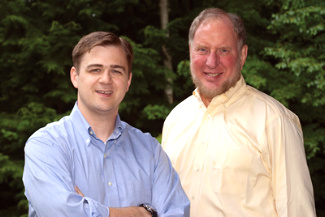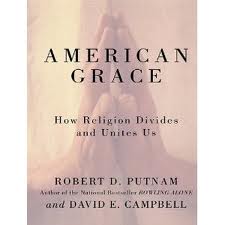Robert D. Putnam and David E. Campbell. American Grace: How Religion Divides and Unites Us. Simon & Schuster, 2010. ISBN: 9781416566717.
Meet the Authors
 Robert D. Putnam (shown in the yellow shirt) is the Peter and Isabel Malkin Professor of Public Policy at the John F. Kennedy School of Government at Harvard University. He has written a dozen books, translated into seventeen languages, including the best-selling Bowling Alone: The Collapse and Revival of American Community and Better Together: Restoring the American Community, a study of promising new forms of social connectedness. Putnam has consulted with national leaders, including US Presidents Bush and Clinton, British Prime Ministers Blair and Brown, Ireland’s Bertie Ahern, and Libya’s Muammar el-Qaddafi. In 2006 he received the Johan Skytte Prize , which is awarded to the scholar who has made the most valuable contribution to political science. Additionally, The Sunday Times of London called him “the most influential academic in the world today.”
Robert D. Putnam (shown in the yellow shirt) is the Peter and Isabel Malkin Professor of Public Policy at the John F. Kennedy School of Government at Harvard University. He has written a dozen books, translated into seventeen languages, including the best-selling Bowling Alone: The Collapse and Revival of American Community and Better Together: Restoring the American Community, a study of promising new forms of social connectedness. Putnam has consulted with national leaders, including US Presidents Bush and Clinton, British Prime Ministers Blair and Brown, Ireland’s Bertie Ahern, and Libya’s Muammar el-Qaddafi. In 2006 he received the Johan Skytte Prize , which is awarded to the scholar who has made the most valuable contribution to political science. Additionally, The Sunday Times of London called him “the most influential academic in the world today.”
David E. Campbell (shown in the blue shirt) is the John Cardinal OHara, C.S.C. Associate Professor of Political Science and the founding director of the Rooney Center for the Study of American Democracy at the University of Notre Dame. He is the author of Why We Vote: How Schools and Communities Shape Our Civic Life, which demonstrates how communities foster civic norms, and how civic norms adopted in adolescence can lead to a lifetime of civic engagement. Campbell is the editor of A Matter of Faith: Religion in the 2004 Presidential Election and a co-author of two books: The Education Gap: Vouchers and Urban Schools and Democracy at Risk: How Political Choices Have Undermined Citizenship and What We Can Do About It.
Book Basics
American Grace explores the religious landscape in America by considering shifts that have happened during the last half century, looking in detail at present beliefs and practices, and offering scholarly suggestions for what changes may mean over the next many years. The historical consideration, relying heavily on data from a variety of well known surveys like the General Social Survey, extends back some fifty years to show not only the nature but also the speed of change. The data regarding present beliefs and practices focuses on original research conducted via the Faith Matters surveys (3108 participants in 2006 then 1909 of that group in 2007). The possibilities of what changes will likely occur in the future are based on the continuation of current trends with a healthy and heavy emphasis on generational shifts.
century, looking in detail at present beliefs and practices, and offering scholarly suggestions for what changes may mean over the next many years. The historical consideration, relying heavily on data from a variety of well known surveys like the General Social Survey, extends back some fifty years to show not only the nature but also the speed of change. The data regarding present beliefs and practices focuses on original research conducted via the Faith Matters surveys (3108 participants in 2006 then 1909 of that group in 2007). The possibilities of what changes will likely occur in the future are based on the continuation of current trends with a healthy and heavy emphasis on generational shifts.
The book’s subtitle, How Religion Divides and Unites Us, provides the focus for the fifteen topical chapters. The first and last chapters offer insight into how people of varying religions and those with no religion have managed to get along together in a deeply religious nation during a time of transitions that have led to religious polarization and pluralism. Between these two are ten chapters examining specific shifts and three chapters that take readers into actual congregations for a look at how religion is experienced on the individual and congregational levels.
So What?
For those who serve in leadership positions in churches in America, understanding the culture here is essential to engaging those who live within it. Often the nature of serving in these roles is such that individuals become experts in those who are like them (other congregations or denominations belonging in similar categories like mainline or evangelical) while having either limited or skewed data about those in other traditions and the increasing group who is tradition-less. This book provides a thorough look at what the people in the pews (and those who don’t frequent them) really believe and do insofar as all things religious. Reading the book will prove an investment that produces dividends measured in years and increased effectiveness.
For a sample of the kind of data and its usefulness in church life, read “Why People Choose Your Church,” which is based on the results of the Faith Matters survey.
I published my “Top Ten Books of 2010” prior to reading American Grace. I would not only place the book on that list, but near the top were I making the list today.
For further study on the topic of American religious belief and practice, I recommend Rodney Stark’s What Americans Really Believe. You can read my review of that text here.